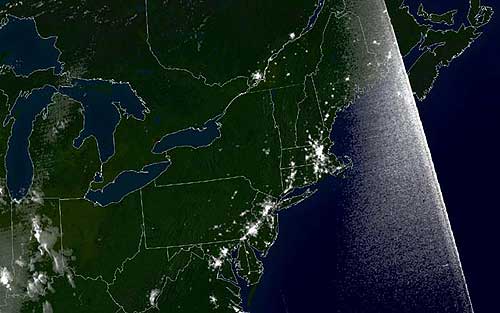 by Ned Rozell September 15, 2003
David Newman studies the workings of complex, chaotic systems as part of his research at the University of Alaska Fairbanks. He and three colleagues wrote a paper in December 2002 about "cascading" power blackouts similar to the largest ever, which affected 50 million people on August 14, 2003. 
From his office on the UAF campus, Newman described the vulnerability of the large systems that bring power to homes in much of North America. "Events like (the blackout of 2003) happen for two reasons: we sit on the teetering edge of collapse with our power demands, plus we're interconnected," he said. Most cities do not have power generators large enough to provide sufficient electricity during times of peak demand, such as a hot summer day in New York City. "If we had to supply each city on its neighboring power plants in times of peak need, forget it," Newman said. To satisfy the call for power at peak times, electrical utilities buy power from other plants. Though Alaska's electrical power systems are separate from the Lower 48, a few large regions of the U.S. are connected. The intertwined nature of the system makes it possible to share electricity, but the connected lines also make the system prone to avalanching power outages, such as the blackout that cut the electricity of 50 million Americans and Canadians in only nine seconds. In a possible scenario for the blackout of 2003 reported in the Cleveland Plain Dealer, a 600-megawatt coal-fed generator in Eastlake, Ohio, shut down. The shutdown tripped a transmission line, then a second line sagged into a tree in a nearby town and shorted out. The damage to the second line shunted too much power to other lines in Ohio, many of which shut down. With so many customers then without electricity, power from generators working at full capacity surged through lines in central Michigan, causing protective relays to trip and shut off power there. In seconds, the same scenario played out from Michigan to Toronto to New York, cutting electricity to a large portion of the U.S. but preventing serious damage to power plants and transmission lines. Newman said a 2 percent increase of U.S. power demand each year and a lack of simultaneous upgrades to power generators and transmission lines could mean more problems. "Couple this to some hot summer days and we have a system sitting on the edge waiting for something to push it over," Newman wrote in an editorial he recently submitted to the Washington Post. Newman said that while it will be possible to prevent the specific problems that caused the 2003 blackout, other, unpredictable problems as small as a squirrel chewing through insulation at a power-transmission substation will continue to threaten the system. For the short term, people can manage the power problem by installing more power wires to spread out the load and by increasing the capacity of power plants. Alaska's problems are similar to those of the Lower 48, but involve different solutions due to a smaller number of adjacent plants supplying extra power. Additional power generation, called spinning reserve, is needed in case a main generator goes off line without warning. Golden Valley Electrical Association is currently testing a battery energy storage system they've built in Fairbanks, fondly called BESS. Costing $35 million, GVEA says BESS is "the world's most powerful storage battery" and will provide 27 megawatts of power for up to 15 minutes. This seemingly short amount of time is enough to cover the starting of backup generators and will allow Railbelt utilities to lower spinning reserve, benefiting members and the environment by using less fuel. According to GVEA's web site, "the BESS will stabilize the local power grid and reduce its vulnerability to events like the recent blackout in the northeastern U. S. and Canada."
Related:
Source of Story:
|